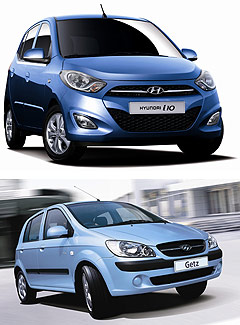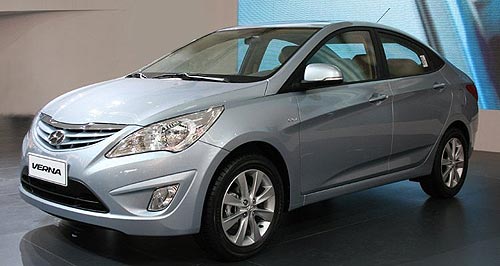Make / Model Search
Future models - Hyundai - i25Accent to fill Getz shoes for HyundaiGetz replacement: The new RB-series Accent four-door emerged as the Verna sedan at the Beijing motor show in April and has been on sale in China for two months. Hyundai to fill Getz void with redesigned Accent sedan within 12 months4 Nov 2010 A NEW Accent sedan will emerge as the missing piece in Hyundai’s light-car puzzle when the long-running Getz is finally retired in the second half of next year. The Getz continues to be built in South Korea exclusively for export to Australia, where it has outsold Toyota’s Yaris to become the nation’s most popular light car this year, but Hyundai Motor Company Australia (HMCA) will be without its price-leading model when stocks of the seven-year-old are exhausted following the end of production in December.  Left: Hyundai MY2011 i10. Below: Hyundai Getz. Left: Hyundai MY2011 i10. Below: Hyundai Getz.To rectify that, HMCA appears set to replace the Getz not with the Indian-built i10 city-car – which remains under consideration for Australian release as a direct rival for Holden’s new South Korean-built Barina Spark and Australia’s pioneering sub-light model, the Suzuki Alto – but with the next-generation Accent sedan. The new RB-series Accent four-door emerged as the Verna sedan at the Beijing motor show in April and has been on sale in China for two months. To be known this time as the Accent rather than the Verna in South Korea, where it was launched this month - and as the Solaris in Russia – the new mini-sedan is likely to be called the i25 when it is released in Australia in the third quarter of next year. While a yet-to-appear replacement for the superseded Accent hatchback that was sold in Australia between 2006 and January this year (when HMCA chose to discontinue the Accent rather than import South Korea’s facelifted version) will go on sale in its domestic market next April, Hyundai appears to be only interested in selling the Accent sedan in Australia. The idea is the new Accent sedan will bolster Hyundai’s presence in the crucial light-car segment, in which it will be represented only by the Indian-built i20 hatchback when the cut price Getz disappears from showrooms midway though 2011. While the seven-year-old Getz micro dates back to October 2003 and is now priced from $12,990 driveaway (in either three-door or five-door guise) in Australia, making it Hyundai’s oldest and cheapest model by a large margin, the i20 was released in July with prices starting from $14,990 plus on-road costs for the 1.4-litre three-door. The outgoing Accent was last priced from $15,490 as a three-door hatchback and close to $17,000 as a sedan (both powered by an 82kW 1.6-litre petrol engine), but expect the pricing and engine line-up of the new i25/Accent sedan to be lineball with the i20, which comes with both 73.5kW 1.4-litre and 91kW 1.6-litre petrol engines matched with five-speed manual and four-speed automatic transmissions. In South Korea, the Accent – which is based on the same platform as the Accent - will come with both 1.4-litre Gamma MPI and 1.6-litre Gamma GDI direct-injection petrol engines, as well as twin front and side curtain airbags, electronic stability control and ABS brakes. As with the i20, a diesel version of the i25/Accent will also be available to HMCA should it choose to introduce an oil-burning light-car. HMCA director of marketing Oliver Mann conceded Hyundai’s sub-$13,000 starting price would vanish with the Getz, marking a quantum shift in the South Korean brand’s approach to selling cars in Australia, but said his company did not intend to surrender its dominant share of the cheapest vehicle segment. “Light cars were our foundation, but i30 is now our volume-seller,” he said, adding that a range of light and sub-light model options remained available to HMCA, including both Accents, the i10 and further variants of the i20, which remains in short supply from India. “Getz production ends in December and we’ll continue to make it available in Australia through the first half of 2011,” said Mr Mann. “We have been looking at the i10 and will continue to do so. It may come but it has not been green-lighted yet. Equally there is (sales) volume potential in i20, which has been supply constrained. “We don’t see ourselves giving away any volume in the light-car segment. We have the option to come down to i10, or other options on the i20 platform. Accent will be available in both sedan and hatch and the situation right now is very fluid. “The decision will be made within the next three months. Having an Accent sedan would increase our volume in the light segment. At the moment i20 is selling 500 a month or 6000 a year, which is clearly not enough to sustain us so we need to increase that in 2011. “So it’s a puzzle in terms of which models will sell best, which models we can secure consistent supplies of from three different factories and the exchange rate ramifications of that – it’s a business case situation. “In three months we’ll know the i20 supply situation and therefore we’ll know what additional models we’ll need to support the i20 in the light-car segment. It could be anything from just the Accent sedan to the Accent sedan and hatch and i10. “The primary concern is to maximise the success of i20. To that end we’re looking at the business case and supply potential of both Accent and i10. “But ultimately we may introduce only the Accent sedan since we already have a five-door light-car in the i20.” Further muddying the light-car waters for Hyundai is the possibility of a three-door version of the new Accent, and a new 1.0-litre three-cylinder petrol engine for the i10, which recently underwent a midlife makeover and is now in the second half of its model cycle. The 3565mm-long i10 is available overseas with both 1.1 and 1.2-litre petrol and 1.1-litre turbo-diesel engines, but senior HMC powertrain executives told GoAuto in South Korea last week that the company’s new Kappa engine will enter production within two months, destined for the next-generation i10 and Kia Picanto. Matched with a continuously variable transmission (CVT), the new DOHC 12-valve 998cc triple employs a two-stage variable inlet manifold and dual variable valve timing – but not direct-injection – to produce 55kW and 94Nm of torque.  Read moreAll future modelsMotor industry news |
Click to shareHyundai modelsResearch Hyundai All future modelsMotor industry news |



 Alfa Romeo
Alfa Romeo Abarth
Abarth Audi
Audi Aston Martin
Aston Martin BMW
BMW Bentley
Bentley Ferrari
Ferrari Chevrolet
Chevrolet Ford
Ford Fiat
Fiat GWM
GWM Foton
Foton Hyundai
Hyundai Honda
Honda Jaguar
Jaguar Isuzu
Isuzu Kia
Kia Jeep
Jeep Land Rover
Land Rover Lamborghini
Lamborghini Maserati
Maserati Lexus
Lexus McLaren
McLaren Mazda
Mazda Mercedes-Benz
Mercedes-Benz Mitsubishi
Mitsubishi Mini
Mini Peugeot
Peugeot Nissan
Nissan Ram
Ram Porsche
Porsche Rolls-Royce
Rolls-Royce Smart
Smart Skoda
Skoda Suzuki
Suzuki Subaru
Subaru Toyota
Toyota Tesla
Tesla Volvo
Volvo Zeekr
Zeekr







Facebook Twitter Instagram